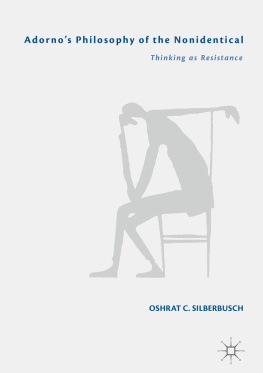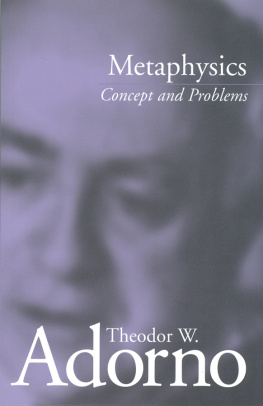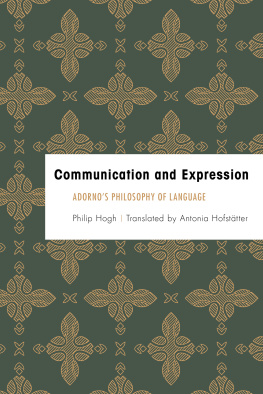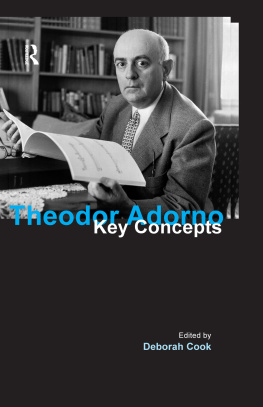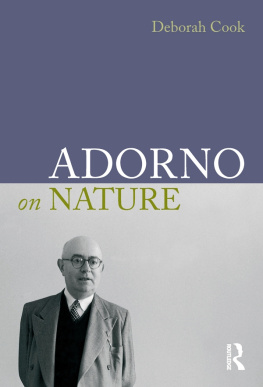WHAT WOULD BE DIFFERENT
Figures of Possibility in Adorno
Iain Macdonald
STANFORD UNIVERSITY PRESS
STANFORD, CALIFORNIA
Stanford University Press
Stanford, California
2019 by the Board of Trustees of the Leland Stanford Junior University. All rights reserved.
No part of this book may be reproduced or transmitted in any form or by any means, electronic or mechanical, including photocopying and recording, or in any information storage or retrieval system without the prior written permission of Stanford University Press.
Printed in the United States of America on acid-free, archival-quality paper
Library of Congress Cataloging-in-Publication Data
Names: Macdonald, Iain, 1966 author.
Title: What would be different : figures of possibility in Adorno / Iain Macdonald.
Description: Stanford, California : Stanford University Press, 2019. | Includes bibliographical references and index.
Identifiers: LCCN 2019004069 (print) | LCCN 2019008421 (ebook) | ISBN 9781503610644 | ISBN 9781503610279 (cloth : alk. paper) | ISBN 9781503610637 (pbk. : alk. paper)
Subjects: LCSH: Adorno, Theodor W., 19031969. | Possibility. | Critical theory. | Sociology. | Philosophy, Modern.
Classification: LCC B3199.A34 (ebook) | LCC B3199.A34 M24 2019 (print) | DDC 193dc23
LC record available at https://lccn.loc.gov/2019004069
Cover image: 2019 Sara Morley and Salvatore V. Barrera
Cover design: Rob Ehle
To my mother and to the memory of my father
CONTENTS
ACKNOWLEDGMENTS
So many colleagues, students, and friendsnear and far and in very diverse wayshave contributed something vitally important to this project: comments, criticisms, research opportunities, technical and archival support, or simply gestures of friendship. Thanks are therefore due to Salvatore Barrera, Don Beith, Jay Bernstein, Karen Borrmann, Isabelle Boucher, Ian Chuprun, Karl Ct, Jrme Cotte, Jen Cressey, Marie-Hlne Desmeules, Martin Desrosiers, George di Giovanni, Olivier Dorais, Gordon Finlayson, Liz Foley, Maxime Fortin-Archambault, Thierry Gendron-Dugr, Christoph Gdde, Peter Gordon, Vincent Grondin, Espen Hammer, Firmin Havugimana, Olivier Huot-Beaulieu, Thomas Khurana, Kathy Kiloh, Sonja Kleinod, Bianca Lalibert, Samuel-lie Lesage, Henri Lonitz, Olivier Mathieu, Rocky McKnight, Laetitia Monteils-Laeng, Christoph Menke and the members of his Kolloquium at the Goethe-Universitt Frankfurt am Main, Ludvic Moquin-Beaudry, Dominic Morin, Marie-Eve Morin, Sara Morley, Pierre-Franois Noppen, Brian OConnor, Max Pensky, Daro Perinetti, Henry Pickford, Scott Prentice, Dirk Quadflieg, Karl Racette, Grard Raulet, Elizabeth Robertson, Yasemin Sar, Michael Schwarz, Xander Selene, Dirk Setton, Martin Shuster, Jamie Smith, Gabriel Toupin, Roseline Vaillancourt, Nick Walker, and Krzysztof Ziarek. In particular, I thank two people without whose support this project never would have seen the light of day: Laurence Ricard and William Ross.
For institutional support of various kinds, I thank the Social Sciences and Humanities Research Council of Canada, the Exzellenzcluster Die Herausbildung normativer Ordnungen at the Goethe-Universitt Frankfurt am Main, the Forschungskolleg Humanwissenschaften in Bad Homburg, the Adorno Archive in Frankfurt am Main, and the Walter Benjamin Archive in Berlin. For permission to quote from Adornos unpublished writings, I also thank the Adorno Archive and the Hamburger Stiftung zur Frderung von Wissenschaft und Kultur.
Some passages appearing in were based on parts of my Adornos Modal Utopianism: Possibility and Actuality in Adorno and Hegel, Adorno Studies 1, no. 1 (2017). An earlier, and shorter, version of this article also appeared in French as Un utopisme modal? Possibilit et actualit chez Hegel et Adorno, in Les normes et le possible: Hritage et perspectives de lcole de Francfort, ed. P.-F. Noppen, G. Raulet, and I. Macdonald (Paris: ditions de la Maison des Sciences de lHomme, 2013).
Finally, some parts of are based on ideas first sketched in my What Is, Is More Than It Is: Adorno and Heidegger on the Priority of Possibility, International Journal of Philosophical Studies 19, no. 1 (2011), and in two articles that first appeared in French: Lautre pense: La possibilit de lautre commencement et la critique de leffectivit dans les Beitrge zur philosophie, in Quappelle-t-on la pense? Le philosopher heideggrien, ed. C. Perrin (Bucharest: Zeta Books, 2014); and Vers une dmodalisation du possible: Heidegger et le clivage de lestre, Philosophie, no. 140 (2019).
ABBREVIATIONS
| BGS | Benjamin, Walter. Gesammelte Schriften. Edited by Rolf Tiedemann et al. 7 vols. Frankfurt am Main: Suhrkamp Verlag, 19721989. |
| GA | Heidegger, Martin. Gesamtausgabe. Edited by Friedrich-Wilhelm von Herrmann et al. Frankfurt am Main: Vittorio Klostermann, 1975. |
| GS | Adorno, Theodor W. Gesammelte Schriften. Edited by Rolf Tiedemann et al. 20 vols. Frankfurt am Main: Suhrkamp Verlag, 19701986. |
| HGS | Horkheimer, Max. Gesammelte Schriften. Edited by Alfred Schmidt and Gunzelin Schmid Noerr. 19 vols. Frankfurt am Main: S. Fischer Verlag, 19851996. |
| MEW | Marx, Karl, and Friedrich Engels. Werke. 43 vols. Berlin: Dietz-Verlag, 1956. |
| W | Hegel, G. W. F. Werke. 20 vols. Edited by Eva Moldenhauer and Karl Markus Michel. Frankfurt am Main: Suhrkamp Verlag, 19691971. |
CHAPTER 1
WHAT WOULD BE DIFFERENT
Ab esse ad posse valet, a posse ad esse non valet consequentia.
I dont think I can give up on possibility, on the thought of possibility. Without it, we would be unable to think at all and indeed, in the strictest sense, nothing at all could even be said.
Adorno to Arnold Gehlen
Right Life
What would be different has not as yet begun. This is how Adorno describes the possibility of a redeemed life in relation to the suffering that stems, in this life, from the perpetuation of ancestral social injustices. This possibility raises a number of questions. One might wonder first of all what precisely would be different? Adorno mentions indications such as the satisfaction of material needs, the elimination of senseless suffering, the redemption of the hopes of the past, the happiness of unborn generations, a humanity that has never yet existed, freedom, peace, and reconciliation.
But how are we to articulate such possibilities without lapsing into a vague and nave utopianism? The answer is far from obvious. The apparent pessimism of the often-quoted claim that wrong life cannot be lived rightly
It should be noted, however, that there is an ambiguity in the impossibility of right life and correct consciousness. Does Adorno mean that there is simply no way to escape wrong life, no really possible right life that would belie the apparent necessity of various forms of suffering and injustice? Or does he mean that the problem of wrong life cannot be solved by a consciousness that takes itself to be correct? In the latter case, Adorno would not necessarily be ruling out the possibility of right life. He would merely be saying that the alternative to wrong life is not to be found in correct life or consciousness, understood in terms of some norm of rectitude to which we must adjust.
The second line of interpretation is the more promising, not least because Adorno explicitly criticizes the notion of correction as rectification, as though a simple adjustment to some available, normatively charged model of existence could set everything right: False opinion cannot be transcended through intellectual rectification alone but only in relation to reality (where reality refers to concretely given material existence).
Next page



